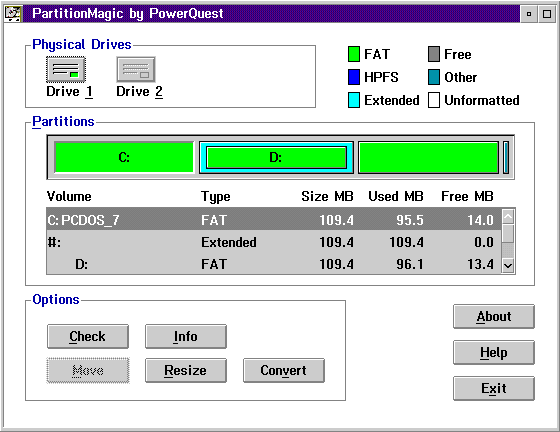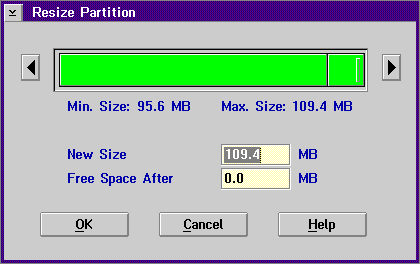PartitionMagic for OS/2: Difference between revisions
(Created page with "By Steven P. Schneer ''PartitionMagic, which'' Personal Systems ''reviewed in "What's New for OS/2?" a couple of issues ago, seemed like a dream come true. So we asked S...") |
No edit summary |
||
| Line 1: | Line 1: | ||
[[ | By [[Steven P. Schneer]] | ||
''PartitionMagic, which'' Personal Systems ''reviewed in "What's New for OS/2?" a couple of issues ago, seemed like a dream come true. So we asked Steve Schneer, a certified OS/2 engineer, to take a look at the program and tell us if it does everything it claims to do. This article describes Steve's very satifactory testing of PartitionMagic from Power Quest.'' | ''PartitionMagic, which'' Personal Systems ''reviewed in "What's New for OS/2?" a couple of issues ago, seemed like a dream come true. So we asked Steve Schneer, a certified OS/2 engineer, to take a look at the program and tell us if it does everything it claims to do. This article describes Steve's very satifactory testing of PartitionMagic from Power Quest.'' | ||
Revision as of 03:48, 22 October 2017
PartitionMagic, which Personal Systems reviewed in "What's New for OS/2?" a couple of issues ago, seemed like a dream come true. So we asked Steve Schneer, a certified OS/2 engineer, to take a look at the program and tell us if it does everything it claims to do. This article describes Steve's very satifactory testing of PartitionMagic from Power Quest.
Have you ever wanted to change the size of the partitions on your hard-disk drive? How about change a partition's file system from File Allocation Table (FAT) to High-Performance File System (HPFS)? Wouldn't it be nice if you could make both of these changes in just a few minutes?
If you support multiple machines that are evolving from DOS/Windows to OS/2 plus DOS/Windows and you want to set up Boot Manager, how do you add Boot Manager without the BACKUP/FDISK/RESTORE routine?
These tasks can be accomplished quickly and easily by using PartitionMagic for OS/2 from Power Quest!
If you've been working on an OS/2 system for a while and the layout of the logical drives wasn't working for you, you had few options--until recently. The most common solution was to back up all of your data, run FDISK to rearrange your partition alignments, then restore your data. If you had a large hard drive and no tape backup unit, you probably didn't bother. It took too much time for the limited benefit. Even with a tape drive, it might have been too risky or time consuming to do this just for a more convenient arrangement. PartitionMagic 1.0 by Power Quest eliminates all these problems. It allows you to modify the partition layout on your hard disk without removing or risking damage to the data or programs already on your hard drive.
Overview
Power Quest provides three versions of the program. First is a Presentation Manager (PM) version that can modify any partitions except the one from which OS/2 is booted. Second is a graphical 32-bit DOS version if you haven't installed OS/2 yet but want to modify your hard disk partitions (i.e., to install OS/2 with Boot Manager). Finally, there is an OS/2 character mode version that you can run from a floppy boot (or maintenance partition) to modify the OS/2 boot partition. I used each of these versions while I prepared this review.
In addition to its main partitioning task, PartitionMagic contains Check and Info functions. The Check function performs the equivalent of a CHKDSK many times faster than CHKDSK itself but does not fix errors (you still have to use CHKDSK for that). The Info function provides detailed information about the physical layout of your partitions and disk.
Sizing Partitions
The initial screens of the PM version and the DOS version are very similar (Figure 1). The top box shows the physical drives on the system. The main box shows the logical layout of the currently selected volume. Below this is the options box for selecting the various actions on partitions. The buttons for help and exit are in the lower right corner.
Figure 1. PartitionMagic Main Screen
When you select a partition to modify, the diagram of the current partition is shown (Figure 2). You can resize the partition by dragging the right or left edge of its block. Likewise, you can expand or contract the partition(s) to the right or left of the partition being changed (assuming there is sufficient free space in the partition to do so).
Figure 2. Resize Partition Window
To be successfully contracted, a partition must have enough free space to "lose" the amount of shrinkage. To be successfully expanded, a partition must have enough free space in the volume to allow the expansion. This translates into the following scenarios: Volume full (no unused space) must shrink one partition to expand the other, or allow addition of a new one. Volume not full must shift the partition either direction and expand or contract up to the limit of available space.
The rearrangement scenarios have an additional limitation if using the FAT file structure: no FAT disk can have more than 65,525 clusters. Because the cluster size is determined at format time, not partition time, this will limit the range of adjustment that PartitionMagic can allow. Also, if the partition being modified is a FAT partition or is bootable, it must reside entirely within the first 1024 cylinders of the physical drive (or have logical remapping done via drivers or the BIOS).
Boot Manager Issues
One of the main reasons I use PartitionMagic is to install OS/2 on a DOS/Windows machine using a Boot Manager setup. I prefer the Boot Manager setup because it allows me to decide at boot time which OS/2 to go to. Since most of the machines I work on do not provide any unused space on the drive, installing Boot Manager requires repartitioning even if there is already a partition that could receive OS/2. PartitionMagic allows me to install with Boot Manager without destroying the existing data on the drive. There still must be sufficient room for the install, but now I won't have to back it up, repartition, and restore just to begin installing OS/2.
In the current release of PartitionMagic, the process described above sometimes causes Boot Manager to lose track of the partition name or its "bootability." Both Power Quest and IBM are investigating this problem. The workaround in the PartitionMagic documentation does work and restored the ability for me to boot with the partition I had resized.
FAT to HPFS Without Tears
If you want to change from FAT to HPFS, PartitionMagic can do the conversion without reformatting. This is presently a one-way change for two reasons:
- Potential file name clash when converting from long file names to FAT's 8.3 format
- Potential problems with FAT cluster sizing
PartitionMagic handled the conversion of extended attributes from the EA DATA.SF file (in FAT) to the directory (in HPFS) without a problem. Several online forum discussions about this during this review prove there is significant interest in being able to change back, but at present it's a one-way operation.
Stacker
I also have Version 4 of Stacker for OS/2 and DOS installed. According to the documentation, PartitionMagic works fine with Stacker. Since Version 4 of Stacker had just been released when I was testing PartitionMagic, I wondered if PartitionMagic had been tested with the new Stacker version. I tested it with both stacked and non-stacked partitions and, with one exception, it worked fine.
The exception was caused by upgrading from Stacker 1.0 to Stacker 4.0. The Stacker upgrade program uses slack space in the FAT table for the additional space available with the Stacker 4.0 release. This slack space is the same space used when Stacker resizes a drive. Since Stacker uses the same space for both purposes, I couldn't expand my stacked partitions until I got the workaround from Stac. If I had been using Stacker 4.0 from the beginning and not an upgrade from Stacker 1.0, I wouldn't have encountered this problem.
Conclusions and Thoughts
The program works very well for a 1.0 release. Initially, I used it very cautiously and had double sets of backups "just in case." I found no evidence of data loss or corruption during the testing. During the testing, a fix was released to resolve minor problems and to provide a diagnostic program, PARTINFO.EXE. This program reports on the partition layout to help resolve technical support questions.
Power Quest strongly recommends a backup before any action (actually, I wouldn't do this type of operation with anyone's product without a good backup). In the case of PartitionMagic, the program worked like a charm and saved me the time I would have spent restoring and verifying all my files.
The documentation could use some improvement. The list of error messages in Appendix C could be enhanced by explaining each error, including typical causes and possible cures.
Power Quest is working hard to eliminate the minor rough edges.

